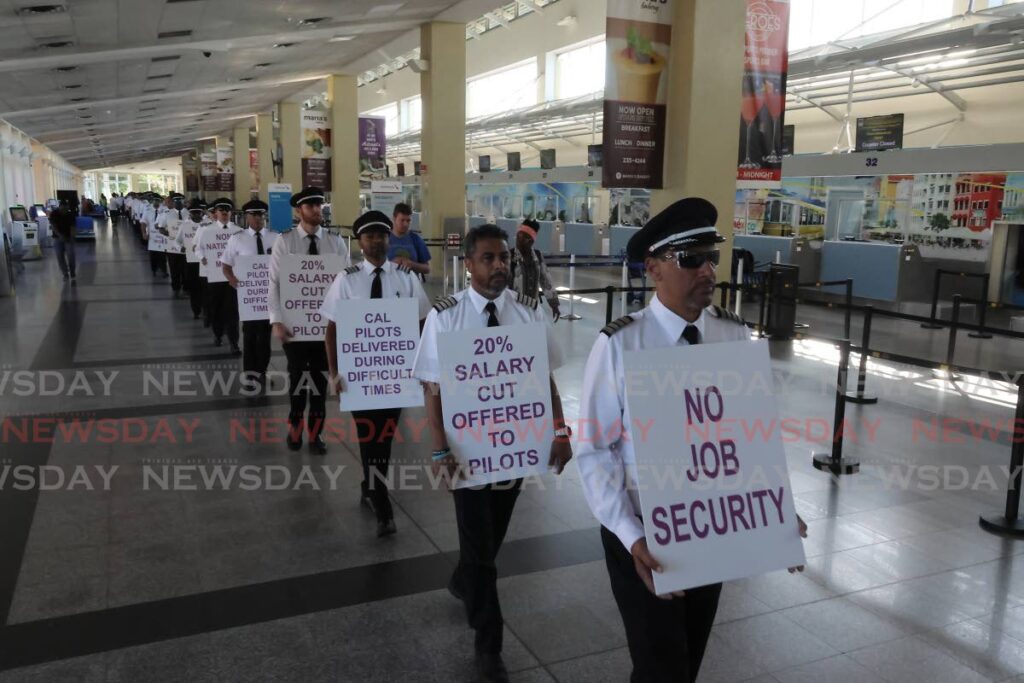Statistics show CAL pilots lowest paid in region

COMPARATIVE WAGES shared exclusively with Newsday by the TT Airline Pilot Association (TTALPA) revealed that Caribbean Airlines Ltd (CAL) pilots are among some of the lowest paid pilots in the region, only being paid more than pilots in the Bahamas.
Pilots continue their plea to settle wage negotiations with CAL and have asked for a four per cent wage increase for the period 2015-2020. On October 3, they highlighted issues affecting them in a picket at the Piarco International Airport.
The statistics showed a CAL captain’s salary is, on average, a little over half the salary of a captain employed with Southwest Airways. The data revealed CAL jet captains receive 42.41 per cent of the wages of a Southwest captain, meaning Southwest captains’ salaries are 57.59 per cent higher.
A first officer with CAL will receive 34.11 per cent of the average salary of a first officer with Southwest, meaning Southwest first officers’ salaries are 65.89 per cent higher than that of a CAL first officer.
CAL captains receive only 49.22 per cent of a United Airlines captain’s salary, meaning they are paid more than 50 per cent less than a UA captain. A first officer in CAL is paid 59.17 per cent less than a first officer at UA, receiving 40.83 per cent of a UA first officer’s salary.
CAL captains are paid 90.72 per cent of a Cayman Airlines jet captain, meaning Cayman Islands captains are paid nine per cent more than CAL captains. First officers in Cayman Airlines are paid 33.59 per cent more than a CAL first officer, who receives 66.41 per cent of a Cayman Airlines first officer’s salary.
“That means that if a Cayman Islands jet captain gets paid $1, a CAL captain will get paid 90 cents,” TTALPA industrial relations consultant Timothy Bailey explained to Newsday.
The only airline with a comparatively lower wage is Bahamas Airways. A CAL jet captain gets 113.58 per cent of the pay of a Bahamas Airways jet captain and a first officer gets 106.58 per cent of a Bahamas Airways first officer. This means that wherever a Bahamas Airways captain gets paid $1, a CAL captain will be paid $1.13, and wherever a Bahamas Airways captain gets $1, a CAL first officer will be paid $1.06.
Further data revealed that a Southwest Airlines captain’s salary ranges from $127,664.81-$141,732 a month, while a Southwest Airlines first officer is paid from $44,683.20-$99,215.58.
UA captains are paid in a range from $123,381.76-$132,394.92, while a first officer is paid in a range from $43,326.23-$90,150.27.
A Cayman Islands jet captain is paid in a range from $63,223.50-73,336.38 and first officers a range from $24,509.70-$52,856.88.
Retired Civil Aviation Authority president Ramesh Lutchmedial said pilots' salaries are based on several factors, the most important being the level of responsibility.
“Pilots have the responsibility of the safety of all the passengers on the aircraft. The pilot must possess the requisite skills and competencies to fly an aircraft from point A to point B safely. Flying requires tremendous skill and discipline,” he said.
He said pilots’ salaries also depend on the aircraft they fly. Captains of larger, more complicated aircraft would get a higher salary than someone flying a smaller plane.
He also said pilots’ salaries are also determined on the cost of living in his or her country.
“You cannot just compare pilots salaries,” he said. “If you pay $5 for a can of Coca-Cola here you may pay $1.50 for that same can in the US. It is all pegged on the cost of living.
“I remember a long time ago BWIA pilots used to say an Air France pilot, flying the same plane that he is flying, was getting twice his salary. But that is because of the cost of living in France. It is very expensive to live in Europe, France in particular.”
He suggested de-linking pilots’ salaries from those of other public servants.
But Bailey said all these factors were taken into consideration during negotiations between CAL pilots and management.
During negotiations the airline offered a seven and a half per cent pay increase for the negotiation period 2015-2020, along with a change from monthly to an hourly payment system.
The breakdown of the payment increase was: zero per cent for the first year, then 2.5 per cent, 2.5 per cent, 2.5 per cent then zero per cent for the period.
The pilots resisted and TTALPA presented a counter-proposal of zero per cent, four per cent, four per cent, four per cent, and one per cent for the bargaining period. It then reduced its counter-offer to zero per cent, three per cent, three per cent, three per cent and one per cent.
Last year, negotiations broke down, leading to 93 pilots calling in sick between August 18 and 20, which caused the cancellation of 60 flights and cost the company an estimated $15 million.
CAL was granted a court injunction on August 21 instructing TTALPA to direct workers to immediately report for duty, despite the union's denying that industrial action took place.
During that time, CAL asked for an extension of the negotiation period, to find a way to settle the issue. Minister of Labour Stephen Mc Clashie confirmed this with Newsday on October 6 and said the extension expires in November.
CAL submitted a proposal to Minister of Finance Colm Imbert to settle negotiations with TTALPA in August. Newsday understands that despite follow-ups and reminders, no response from the ministry has been forthcoming.
Newsday contacted minister in the Ministry of Finance Brian Manning. While he did not have a comment, he told Newsday the minister will make a statement on the matter soon.

Comments
"Statistics show CAL pilots lowest paid in region"